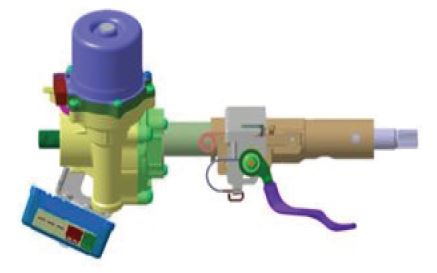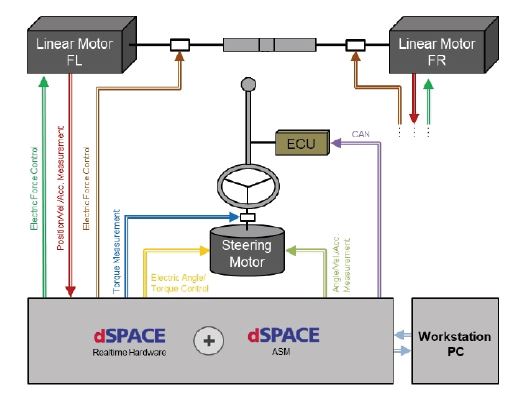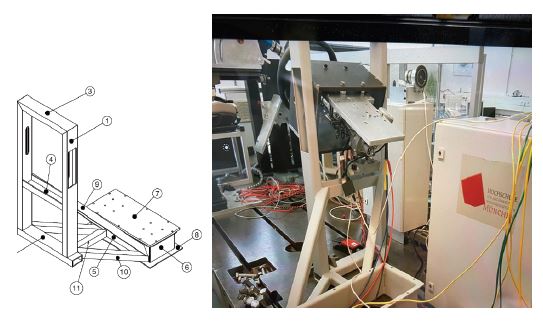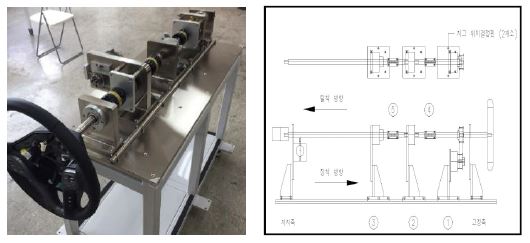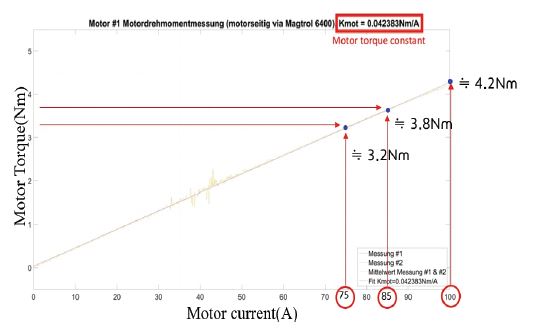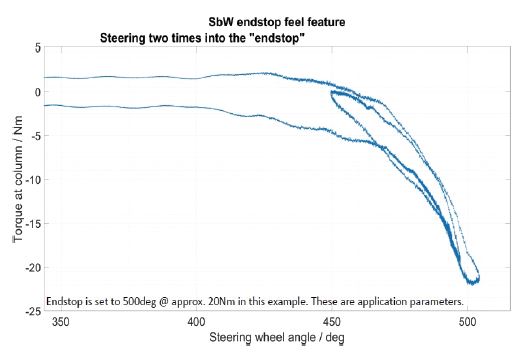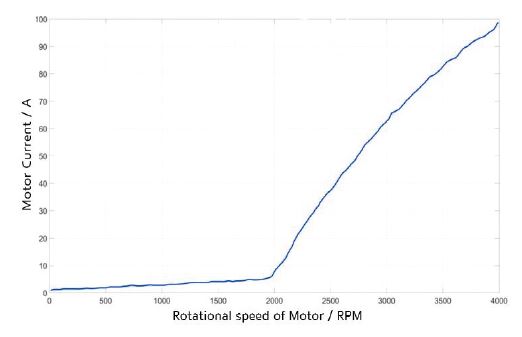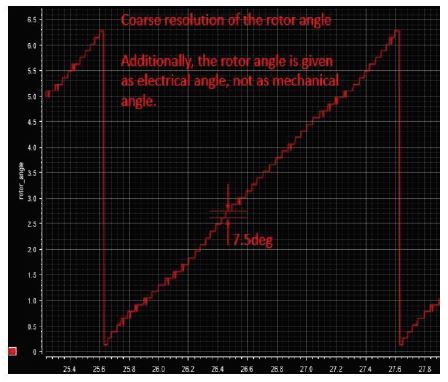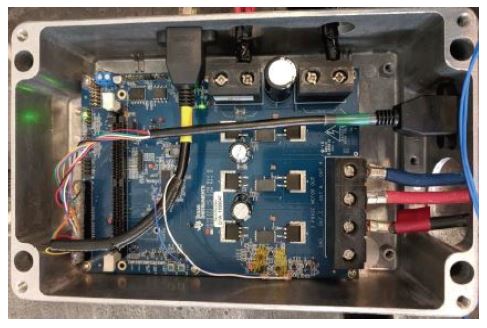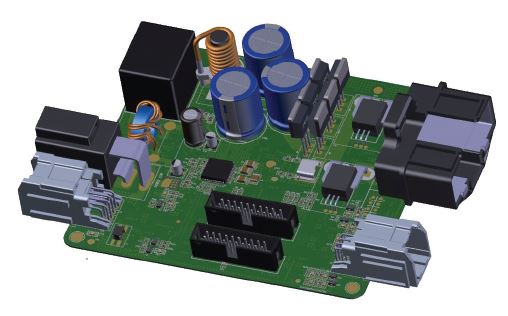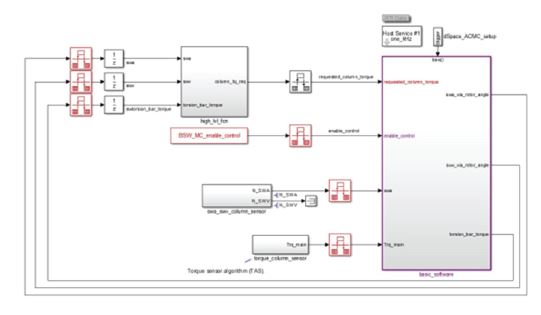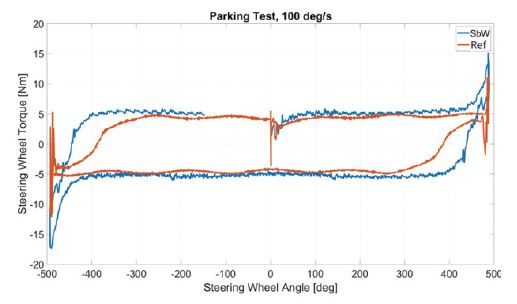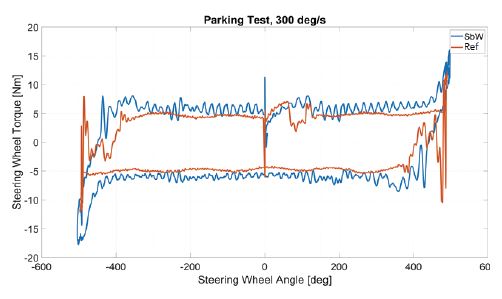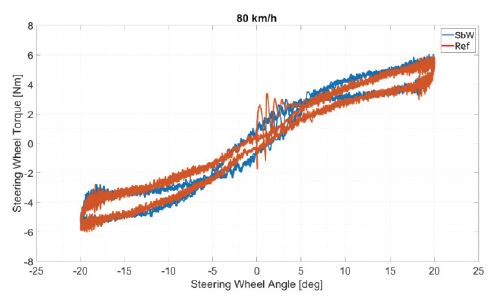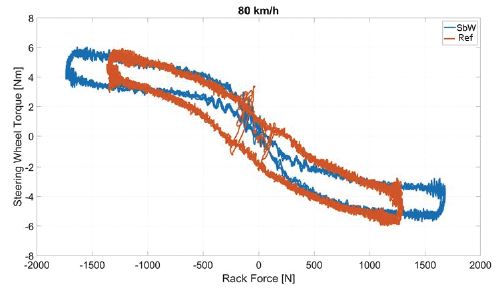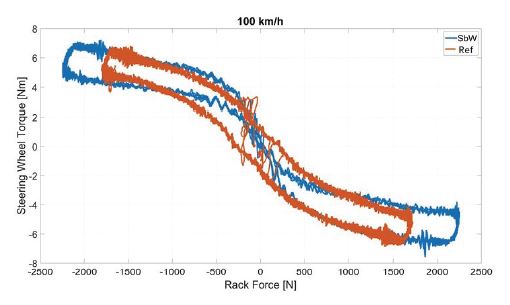
A Study on the Steering Force Feedback Control of the Steer by Wire System Using HiLS
Copyright Ⓒ 2021 KSAE / 182-07
This is an Open-Access article distributed under the terms of the Creative Commons Attribution Non-Commercial License(http://creativecommons.org/licenses/by-nc/3.0) which permits unrestricted non-commercial use, distribution, and reproduction in any medium provided the original work is properly cited.
* A part of this paper was presented at the KSAE 2019 Fall Conference and Exhibition
Abstract
This paper focuses on the Steer-by-Wire system as the next-generation steering system to be applied to autonomous driving vehicles. This paper covers a study of the Force Feedback Unit in the Steer-by-Wire system that affects the driver’s steering feel. In order to design the Force Feedback Unit, we analyzed the dynamic motion of the vehicle and related parameters, and applied them to the vehicle dynamics simulation(dSPACE, ASM) on HiLS. In the Steer-by-Wire system, the Force Feedback Unit control algorithm for the column was designed based on a model (MATLAB and Simulink) and the performance was validated at the Hardware-in-the-Loop level.
Keywords:
Force feedback unit, Steer-by-wire system, Electronic power steering system, Steer end stop protection, Motor field weakening control1. Introduction
News reports on the development and verification of driving safety systems to prevent accidents due to drivers’ careless behavior or bad weather are increasing. With the development of these technologies, autonomous driving systems that allow drivers to rest comfortably while driving will become universal soon. In view of these trends, we can predict that the driver’s steering intervention in vehicles that are capable of fully autonomous driving will be very limited in the future.
However, even with autonomous driving systems, we still need to develop a steer by wire(SbW) system that allows the driver to intervene in worst-case scenarios. Hence, research institutes and related companies are promoting the development and verification of SbW systems.
Unlike recent studies that developed separate devices for system separation or integration, this study aims to provide drivers the same steering feel as that of the existing electronic power steering system(EPS) by measuring direct dynamic parameters while maintaining the EPS, and by applying such parameters to the control of the SbW steering reaction force.
To that end, this study researched and developed a system that provides drivers the same EPS steering feel by merely modifying the software while maintaining the mechanism, motor(actuator), and sensors of the existing column-type EPS. Another advantage of this development method is that it does not require additional review or verification of the relevant laws and regulations.1-7)
2. Design of the SbW FFU Specifications and Environmental Setup
To set the performance goal of the SbW force feedback unit(FFU) system, the performance of the EPS steering system mounted in the target vehicle was evaluated in advance. Using the steering and dynamic characteristics of the EPS that were identified in the evaluation, a virtual vehicle model was designed with the dSPACE ASM (Automotive Simulation Models). Furthermore, based on the performance and characteristics of the motor applied to the existing EPS, a field weakening controller was designed and tested to generate a high torque output in high-speed rotations when the motor applied to the SbW column is controlled.
2.1 Determination of the Specifications of the SbW FFU Column
The column-type EPS that was used to develop the SbW FFU is shown in Fig. 1. It was purchased from the mass-produced Avante model. It was selected because we believed that if only the EPS control logic in the ECU (electronic control unit) of the current column-type EPS system could be changed to the SbW FFU control logic and if its performance could be verified, it would at least reduce the certification and legal procedures for the mechanism.
The characteristics of the column-type EPS are as follows:
- ⋅ Rake & Telescopic
- ⋅ Torque & Angle Sensor
- ⋅ 540 W BLAC motor
- ⋅ Worm Gear ratio = 20.5 : 1
2.2 HiLS Control and Measurement Signal Flow
Based on the information collected from the steering evaluation of the target vehicle, we plan to achieve 80 % or higher agreement of the steering performance with the basic EPS steering performance considering the errors of the HiLS tester in the first year of the SbW FFU development process. Later, we plan to achieve 95 % or higher agreement by improving the tester and applying an additional compensation logic.
The HiLS test environment that can perform SbW parameter tuning to satisfy the first-year goal was set up as shown in Fig. 2.
Furthermore, a strain gage was attached to the rack bar in the target vehicle with which the changes in the force of the rack bar during steering were measured within the total speed range of the vehicle. The measurement results are shown in Fig. 3. These results were also used in the virtual vehicle model design(dSPACE ASM) of the HiLS system and in the design of the SbW FFU algorithm.

Results of the measurement of the rack force versus the steering torque according to the vehicle speed
Fig. 3 shows a graph of the rack force variations against the driver’s steering torque according to the vehicle speed.
2.3 Design of the Fixing Jog for the SbW FFU HiLS Test
To fix the column-type EPS and the rack-type EPS based on the drive line design coordinates of the target vehicle, the jig was designed and fabricated as follows. In addition, a separate fixing jig was fabricated to enable the attachment and detachment of the SbW column.
In Fig. 4, in the design drawings on the left, ① and ⑦ were designed to allow the attachment of the SbW column and the rack EPS, respectively.
However, the design needs to be improved because if errors occur in the design and fabrication process, a new fixing jig must be fabricated.
2.4 Test Bench Setup for the SbW FFU Control
A test bench for analyzing the correlations and effects of existing products for control of the SbW FFU was set up. It is shown in Fig. 5. The purpose of this test bench was to determine the parameters and their ranges to be managed when the mechanical design values need to be changed later by analyzing the performance factors of the SbW FFU of each product.
A jig guide fixing bar and a separate eccentricity measuring instrument were later mounted next to each jig to prevent the deviation of the central connecting shaft between the component products in the test bench.
2.5 Results of the Control Test of the Motor to Be Applied to the SbW FFU
The results of the test of the single-product performance of the motor for SbW FFU control is shown in Fig. 6.
After analyzing the graph of the measurements in Fig. 6, the motor torque constant(Kmot) was determined as 0.042383 Nm/A.
As shown in Table 1, all the results satisfied the SbW FFU target output torque of 20 Nm or higher.
The target output torque was higher than 20 Nm because the SbW system structure does not have a mechanical connection between the column and the steering gear(the rack and pinion). Thus, the driver cannot determine the maximum tire and steering angles unless there is an additional stopper in the column. To address this problem and to inform the driver that the wheel and the tire have reached the maximum value in one direction, the steering torque was increased to a certain slope to maintain the maximum torque of 20 Nm using the motor’s rotational speed and position control. Furthermore, the 20Nm setting is similar to the design range of the existing EPS steering performance. The result is shown in Fig. 7. The implementation of this performance was a requirement of the customer.
2.6 Results of the Test of the Field Weakening Control of the Motor
For the field weakening control of the motor applied to the SbW FFU, the controller was designed and verified so that the control would begin from 2,000 rpm(revolutions per minute) of the motor and continue until 4,000 rpm. If the rpm of the motor is converted to the worm gear ratio of 20.5 : 1 applied to the column, field weakening control is possible until approximately 1,170 deg/sec of the driver’s input steering angular speed. This range was considered the maximum steering angular speed input range that the driver can generate during driving. Fig. 8 shows a graph of the results of the field weakening control of the motor only in the tester.
2.7 Analysis of the Motor Sensor Output Signals
The precision(measuring unit) of the encoder signals applied to the inside of the motor in the process of drawing the above-mentioned motor control result was larger than the expected value of 1 deg, as shown in Fig. 9.
As shown in Fig. 9, the motor rpm was measured with a precision of 7.5 deg. This result may indicate a low effect on the motor control ripples for use in the EPS, but it was considered as having a possible effect on the ripples in the SbW FFU system. This result can be confirmed by the ripples(vibrations) in Figs. 15~20.
2.8 SbW FFU Hardware Controller
The hardware setup for the driver implementation of the SbW FFU system through the steering torque and the angle input is shown in the following photograph.
The power electronics hardware(3-Phase BLAC Kit) based on TI’s DRV8302 Gate Driver was used, as shown in Photo. 1. To connect the MicroAutoBox and the EPS motor, the hardware was partially modified so that the SbW FFU system can output sufficient motor control performance.
Based on the first developed kit, our company (Namyang Nexmo) self-produced an embedded hardware that can control the 3-phase BLAC motor.
The hardware of the first developed kit was composed of a current sensor and Shunt Resister for detecting the motor current, Infineon’s motor driver IC for controlling the drive PWM output signals, and the power MOSFET for driving the 3-Phase BLAC motor, as shown in Fig. 10.
3. Design and Implementation of the S bW FFU Control
Before designing the SbW FFU control logic, the influence parameters were analyzed by referring to the design of the steering column, the object of control, based on mathematical modeling.
In the entire scope of the SbW FFU system, the total control flow of the closed-loop virtual vehicle model and the SbW FFU control unit was designed as follows.
3.1 Configuration of the SbW FFU Control Architecture
As shown in Fig. 11, when the driver’s steering input is measured by the sensor, and the rotational position current signals of the motor are inputted into the virtual vehicle modeling control module and the SbW FFU control module, the SbW FFU control module calculates the assist and damping current that the motor must output based on the input signals, and transfers it to the motor control module. Using the input signals, the motor current control module outputs the motor control signals according to the field weakening control, torque ripple compensation, and overload protection control logic. Using the output signals, the power electronics hardware (3-Phase BLAC Kit and primary embedded hardware) controls the rotation of the motor mounted in the SbW column.
The interface of the input and output information between the SbW FFU ASW(Application Software) control module and the closed-loop virtual vehicle modeling control module is shown in Fig. 12.
3.2 Design and Verification of the Model-Based SbW FFU
To perform the model-based design of the SbW FFU controller, the kinematic connection structure of the column EPS was identified. Based on such structure, the FFU controller was designed according to a model, using MATLAB & Simulink. To verify the performance of the designed controller, it was tested at the HiLS level using MicroAutoBox.
The current steering system of the column-type EPS is simply illustrated in Fig. 13.
In the column-type EPS steering system, the driver’s steering input is transferred to the torsion bar, and the sensor collects information. Then the ECU controls the auxiliary torque of the motor according to the vehicle speed. Based on this method, the present study created a map by directly measuring the rack force for each vehicle speed of the target vehicle type, and designed the FFU by tuning the friction force of the coluumn and damping parameters and then designing and controlling the steering reaction force map.
| (1) |
| (2) |
The mathematical modeling was designed using Eqs. (1) and (2).
3.3 Design and Verification of the SbW FFU Simulink
The SbW FFU was designed using MATLAB & Simulink for real-time control and simulation. The RTI block (including ACMC) supplied by dSPACE was used to receive analog and digital signals from the sensors that can measure the driver’s steering torque and angle. Furthermore, the input and output ports were configured to connect them to the ASM vehicle model supplied by dSPACE.
As shown in Fig. 14, the block module on the top left was designed using the mathematical model of the vehicle and the SbW FFU control logic, and the block module on the right was designed using the motor control logic.
The logic was designed in such a way that the rotational direction and speed of the motor can be controlled by receiving the calculated target column torque value according to the vehicle speed and rack force from the top left, and the signal values of the column torque(including the angle) measured from the driver input from the block module.
Furthermore, the total control logic was designed with a feedback system structure, and the Rate Transition Blocks and Trigger were applied to the input and output to adjust the control speed(the sampling time).
3.4 Analysis of the Results of the Evaluation of the SbW FFU Performance
The performance of the SbW FFU was evaluated at the HiLS level in largely two modes first.
Besides the evaluation modes presented in this paper, an additional test will be conducted in which the steering wheel is restored to neutral when the driver inputs a certain steering angle within 1 second and releases it at the vehicle’s low speed(10~30 km/h) and medium speed(40~60 km/h).
As shown in the result graph in Fig. 15, when the driver entered a wheel angular speed of 100 deg/sec, the steering hysteresis appeared similar to the steering hysteresis of the EPS system. However, when the driver’s steering angular speed input increased(to 300 deg/sec), as shown in Fig. 16, vibrations were generated near the maximum value of the wheel angle. This is considered to be generated by the field weakening control logic and the torque ripple compensation logic during motor control and can be solved by parameter tuning.
Furthermore, a sudden increase in the wheel torque was observed in the maximum steering angle range of the wheel. To solve this problem, an additional logic was designed to control the rotational position of the motor through the motor’s rotational speed position control when the wheel steering angle increases to 400 degrees or more.
As shown in the graphs in Figs. 17~20, the reaction force control performance of the SbW FFU was evaluated by entering the driver’s steering angle as a constant value(20 degrees) in the driving state.
As shown in the above graph of the steering performance evaluation results, the performance curve of the steering reaction force control results of the SbW FFU was similar to the steering on-center handling performance curve of an actual vehicle(Ref). However, near the driver’s steering angle of 5 degrees, the width of the SbW FFU steering performance curve became narrow and almost closed. This is considered to be due to the low mechanical friction force of the steering column, which was the object of the experiment. To solve this problem, additional research is underway to develop a separate mechanical friction force generating part and install it or a torque compensation control method using a motor.
In addition, as shown in the graphs in Figs. 19 and 20, the rack force exhibited a shape similar to the target vehicle type, but it appeared larger than that of the target vehicle type at the maximum point. To solve this problem, we are considering the application of an additional rotational angle sensor in the rack gear box.
In particular, the driving speed section of 80~100 km/h requires steering sensitivity and safety while the driver is driving the vehicle. Moreover, additional active damping control design is also being considered to attain a more elaborate and reliable steering feel.
4. Conclusion
In this study, we selected a target vehicle type to which to apply the SbW system and collected steering performance indicators through prior evaluation of the steering of the target vehicle type. Then we developed a steering reaction force feedback unit(FFU) that can exhibit a steering performance similar to that of the existing EPS steering system.
The HiLS test results showed that there are still technical problems that require improvement of the performance. However, this study does not propose the production of separate components of the SbW column. Instead, this study proposes a method of implementing an FFU of the SbW system by changing only the ECU control logic in the existing EPS system and presents the experiment results.
- 1) To measure the rack force according to the vehicle speed when evaluating the steering performance of the target vehicle type, a separate sensor(strain gage) was mounted inside the vehicle.
- 2) To measure the performance of the motor to be mounted in the SbW column and to control the motor, the performance measurement and control of the motor product were designed and connected with the FFU logic of the SbW column.
- 3) Virtual vehicle and column models were designed based on the measurements of an actual vehicle and used to design the control logic of the FFU of the model-based SbW column.
- 4) The differences between the control performance of the SbW FFU and the existing EPS steering performance were verified by key parameter tuning and complementary logic. The verification was implemented only by motor control to enable lock to lock at the maximum steering angle without separate mechanical devices. Additional research is being planned to establish and reproduce the range of torque ripples(e.g., the frequency by vibration with the tire and ground) generated in the test process according to the vehicle speed.
- 5) Based on the above primary year research results, in the second year, we plan to conduct research on the verification of the performance in PG by applying the results to actual vehicles.1-7)
Subscripts
| FFU : | force feedback unit |
| EPS : | electronic power steering system |
| SbW : | steer-by-wire system |
| PG : | proving ground |
| FW : | field weakening |
Acknowledgments
This study was conducted as a joint research with MdynamiX AG of the Munich University of Applied Sciences in Germany.
References
-
M. Harrer and P. Pfeffer, Steering Handbook, Springer, Switzerland, pp.442-443, 2017.
[https://doi.org/10.1007/978-3-319-05449-0]

- H. S. Kim, C. J. Kim, K. H. Kim and C. S. Han, “Development of Active Steering Control Using the Tie-Rod Actuating-Type SBW System,” KSAE Fall Conference Proceedings, pp.783-788, 2006.
- C. J. Kim, K. H. Kim, H. S. Kim and C. S. Han, “Development of a HILS System for EPS & SBW,” KSAE Spring Conference Proceedings, pp.934-938, 2006.
- C. K. Kim, J. H. Yoo and S. B. Lee, “The Development of Driver Torque Estimation Logic of MDPS,” KSAE Spring Conference Proceedings, pp.343-345, 2017.
-
T. G. Lee, M. G. Kim and Y. S. Kang, “Nonlinear Model Prediction Controller Strategy Considering Velocity Reduction by a Large Steering Angle in an Extreme Maneuver,” Transactions of KSAE, Vol.27, No.2, pp.133-144, 2019.
[https://doi.org/10.7467/KSAE.2019.27.2.133]

- C. H. Lim, M. H. Kim, K. C. Lee and S. Lee, “Implementation of the Feedback Control System for the Steer-by-Wire System,” KSAE Spring Conference Proceedings, pp.501-506, 2005.
- S. J. Lee, Y. K. Lee, H. Y. Jeong and M. H. Lee, “A Study on Development Force Feedback Unit of Steer-by-Wire,” KSAE Fall Conference Proceedings, pp.635-641, 2019.
